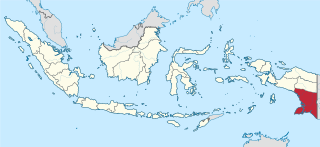
Dead Birds is a 1963 American documentary film by Robert Gardner about the ritual warfare cycle of the Dugum Dani people who live in the Baliem Valley in present-day Highland Papua province on the western half of the island of New Guinea in Indonesia. The film presents footage of battles between the Willihiman-Wallalua clan and the Wittaia clan with scenes of the funeral of a small boy killed by a raiding party, the women's work that goes on while battles continue, and the wait for enemy to appear. In 1964 the film received the Grand Prize "Marzocco d'Oro" at the 5th Festival dei Popoli rassegna internazionale del film etnografico e sociologico in Florence, Italy, the Robert J. Flaherty Award given by the City College of New York, and was a featured film at the Melbourne Film Festival. In 1998, Dead Birds was included in the annual selection of 25 motion pictures added to the National Film Registry of the Library of Congress. being deemed "culturally, historically, or aesthetically significant" and recommended for preservation. Dead Birds has come to hold canonical status among ethnographic films.

Western New Guinea, also known as Papua, Indonesian New Guinea, and Indonesian Papua, is the western, Indonesian half of the island of New Guinea. Since the island is alternatively named Papua, the region is also called West Papua.

The koteka, also referred to as a horim or penis gourd, is a penis sheath traditionally worn by native male inhabitants of some ethnic groups in New Guinea to cover their penises. The koteka is normally made from a dried-out gourd, Lagenaria siceraria, although unrelated species such as pitcher-plant are also used. The koteka is held in place by a small loop of fiber attached to the base of the koteka and placed around the scrotum. A secondary loop placed around the chest or abdomen is attached to the main body of the koteka.

Puncak Trikora, until 1963 Wilhelmina Peak, is a 4,730 or 4,750-metre-high (15,584 ft) mountain in the Highland Papua province of Indonesia on New Guinea. It lies in the eastern part of the Sudirman (Nassau) Range of the Maoke Mountains.
The Lani are an indigenous people in Puncak, Central Papua and Lanny Jaya, Highland Papua, usually labelled 'Western Dani' by foreign missionaries, or grouped—inaccurately—with the Dani people who inhabit the Baliem Valley to the east.

The Baliem Valley is a valley of the Central Highlands in Western New Guinea, specifically in the province of Highland Papua, Indonesia. The main town in the valley is Wamena, which lies on the Baliem River. The valley is about 80 km in length by 20 km in width and lies at an altitude of about 1,600–1,700 metres (5,200–5,600 ft), with a population of over 200,000.
Wamena, also known as the District of Wamena, is a large town in the Western New Guinea region of Indonesia. It also serves as the seat of Jayawijaya Regency. It is the largest town in the province of Highland Papua, located in the Baliem Valley and had a population of 64,967 in the 2020 Census; the official estimate in mid 2022 was 65,766. Wamena is the urban centre of a rural area housing Highland Papua's highest concentration of population, with over 300,000 people inhabiting the Baliem Valley and surrounding areas. These people belong to several related ethnic groups, the most prominent of which are the Dani, Lani, and Yali.
The Koteka are the claimed self-identification for seven major koteka-wearing ethnicities of the highlands of Western New Guinea in Indonesia with a common culture: the Lani, Mee, Amungme, Moni, Damal, Yali and Nduga.
The Dani or Baliem Valley languages are a family of clearly related Trans–New Guinea languages spoken by the Dani and related peoples in the Baliem Valley in the Highland Papua, Indonesia. Foley (2003) considers their Trans–New Guinea language group status to be established. They may be most closely related to the languages of Paniai Lakes, but this is not yet clear. Capell (1962) had posited that their closest relatives were the Kwerba languages, which Ross (2005) rejects.

Yali are a major tribal group in Highland Papua, Indonesia, and live to the east of the Baliem Valley in the Papuan highlands, mainly in Yalimo Regency, Yahukimo Regency, and the surrounding regencies. The Yali and Dani word for "lands of the east" is "yali", from where the Yali took it, without it being a self-identification for their tribe.

Jayawijaya Regency is one of the regencies (kabupaten) in the Indonesian province of Highland Papua. It occupies an area of 13,925.31 km2 in the Baliem Valley, situated in the central highlands of the province. It had a population of 196,085 at the 2010 Census, and 269,553 at the 2020 Census; the official estimate as of mid-2022 was 277,923 - comprising 144,500 males and 133,423 females. Its capital is the town of Wamena.
The Baliem River is a river in the Highland Papua and South Papua provinces of Western New Guinea, Indonesia. It is the largest tributary of the Pulau River, formerly called the Eilanden River. With a total length of 414.2 km (257.4 mi).
Western Dani, or Lani, is the most populous Papuan language in Indonesian New Guinea. It is spoken by the Lani people in the province of Highland Papua. The Baliem Valley tribes are called Oeringoep and Timorini in literature from the 1920s, but those names are no longer used.
The Damal or Damalme are a group of people living in the highlands of the Central Papua province of Indonesia. They primarily live in Beoga Valley along the river of Beogong. The Damal people are closely related to the Delem people, and with the Amungme people living in the southern lowland region. Delem is an ethnic group reportedly descended from the Damal people, Dani people, and Wano people.
Grand Valley Dani, or simply Dani, is one of the most populous Papuan languages in Indonesian New Guinea. The Dani people live in the Baliem Valley of the Western Highlands.
Yali is a Papuan language of Indonesian New Guinea. The Yali people live east of the Baliem Valley, in the Western Highlands.

South Papua, officially the South Papua Province, is an Indonesian province located in the southern portion of Papua, following the borders of the Papuan customary region of Anim Ha. Formally established on 11 November 2022 and including the four most southern regencies that were previously part of the province of Papua and before 11 December 2002 comprised a larger Merauke Regency, it covers an area of 117,849.16 km2, and it had a population of 522,215 according to the official estimates for mid-2022, making it the least populous province in Indonesia.

Central Papua, officially the Central Papua Province is an Indonesian province located in the central region of Western New Guinea. It was formally established on 11 November 2022 from the former eight western regencies of the province of Papua. It covers an area of 61,072.92 km2 and had an officially estimated population of 1,430,951 in mid 2022. It is bordered by the Indonesian provinces of West Papua to the west, the residual province of Papua to the north and northeast, by Highland Papua to the east. and by South Papua to the southeast. The administrative capital is located in Wanggar District in Nabire Regency, although Timika is a larger town.

Highland Papua is a province of Indonesia, which roughly follows the borders of Papuan customary region of Lano-Pago, shortened to La Pago. It covers an area of 51,213.34 km2 (19,773.58 sq mi) and had a population of 1,430,459 according to the official estimates as at mid 2022.
Nothofagus brassii is a species of tree in the family Nothofagaceae. It is endemic to New Guinea. It is commonly known as Sagé, sagé hitam, sahé, and kayu sagé, kayu sagé hitam (Indonesian).











